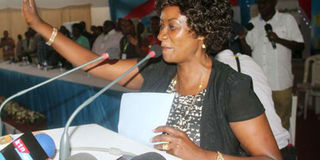Fewer female teachers in school management positions: report

TSC chief executive officer Nancy Macharia closes the primary school head teachers annual conference at Sheikh Zayed hall on August 11, 2016. PHOTO | LABAN WALLOGA | NATION MEDIA GROUP
What you need to know:
- The national assessment system for monitoring learner achievement survey by Kenya National Examination Council (Knec) indicates that male head teachers accounted for 75.8 per cent while female head teachers were only 24.2 per cent in primary schools.
- Over 50 per cent of head teachers reported to have benefited to a large extent from in-service in areas of school administration (84.6 per cent), curriculum implementation (78.1 per cent), management of school resources (75.3 per cent), guidance and counselling (62.4 per cent) and financial management (56.0 per cent).
Fewer female teachers are in school management compared to their male counterparts, a study by a government agency has revealed.
The national assessment system for monitoring learner achievement survey by Kenya National Examination Council (Knec) indicates that male head teachers accounted for 75.8 per cent while female head teachers were only 24.2 per cent in primary schools.
There are more than 23,000 primary schools in the country.
The study also revealed that 39.6 per cent, 38.7 per cent and 39.4 per cent of teachers did not visit curriculum support centres in 2015, 2014 and 2013 respectively.
“There were teachers who had not been assessed by quality assurance and standards officers (DQAS) in 2015 (20.5 per cent), 2014 (17.5per cent) and 2013 (16.9 per cent),” it adds.
About 14.1 per cent of the teachers reported that Educational Assessment and Resource Centres (EARCs) did not exist in their sub counties.
Over 50 per cent of head teachers reported to have benefited to a large extent from in-service in areas of school administration (84.6 per cent), curriculum implementation (78.1 per cent), management of school resources (75.3 per cent), guidance and counselling (62.4 per cent) and financial management (56.0 per cent).
“Some head teachers had not benefited at all from training in SNE, ICT and performance appraisal system at 20.5 per cent, 14.7 per cent and 11.8 per cent respectively,” adds the report.
Nationally, the study states that the overall teacher shortage stands 27.7 per cent. The Ministry of education has indicated that the shortage is 87,000.
“It was observed that 91.6 per cent of pupils were free to talk to their teachers when they had a problem. This denotes a conducive learning environment,” adds the study.
Sickness accounted for the highest percentage of absenteeism (73. 2per cent), followed by lack of school fees (20.5 per cent) and lack of uniform (16.8 per cent) for pupils.
The study also notes that factors affecting syllabus coverage include inadequate teachers (64.7 per cent), time wastage (57.5 per cent), frequent absenteeism by pupils (50.9 per cent) and frequent absenteeism by teachers (47.7 per cent).
The study was conducted in December last year in all the 47 counties with the objective of finding out the personal, home background and school-based characteristics of Standard Three pupils, the personal and professional characteristics of their English, Kiswahili, Mathematics and Life Skills teachers and also the personal and professional characteristics of primary school head teachers.
A total 247 schools, 247 head teachers, 466 teachers and 5,522 pupils were involved in the study.





